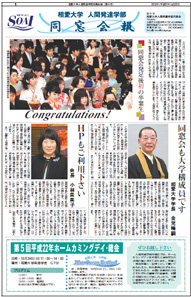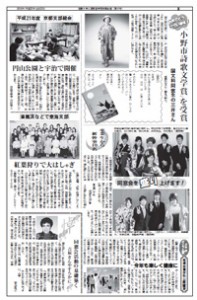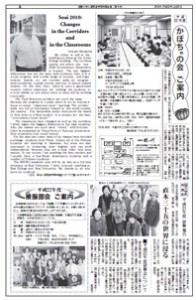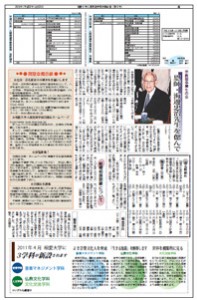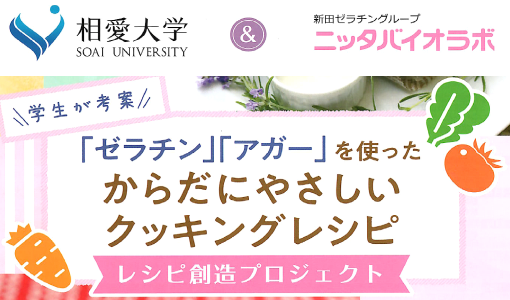2010年4月22日発行
※1ページずつ見られる方は、下記の画像をクリックしてください。
※上記で個々の問い合わせ先を伏せているものに関しては、すべて事務局までご連絡下さい。
上記同窓会会報4号では、誌面の関係でブロデリック先生のご挨拶の全文及び訳を掲載することはできませんでしたので、下記に掲載致します
Soai 2010: Changes in the Corridors and in the Classrooms
First of all, I would like to thank Ms. Kobayashi of the Alumni(ae) Association for allowing me to write a brief greeting to the association members and to all Soai graduates.
I would particularly like offer my best wishes to the graduates of the Junior College, where I spent most of my career at Soai. The Junior College is very well represented in the Humanities Faculty of Soai University, where I am teaching now. Two of my colleagues from the Junior College have taken on particularly important responsibilites: Professor Suzuki is the Dean of Faculty, and Professor Ishikawa is the Administrative Dean. They have worked very hard directing the Faculty from day to day, and also on the restructuring of the Faculty that is taking place, to enable Soai University to meet the challenges of a changing educational environment in the 21st century.
My office is still in the building we referred to as the Junior College building. The room numbers still begin with the letter “C,” but the building, like most others on the campus, now has a number. Please come to the campus sometime so you can learn what number it is!
The corridors near my office are where the new Child Development Department is located. The two biggest differences from when the Junior College was there are the that the program is “co-educational,” with lots of male students, most of whom want to teach in elementary schools eventually; also, it is a 4-year program, with a wide range of courses and huge bulletin boards on the corridor walls, for program announcements, posting of outside events, and lots of career-related notices. On the first floor, there is even a good-sized nursery school classroom, used for training the students in a space similar to where many of them will be working eventually, even though there is not an actual nursery school in operation there, although there have been a few times when visiting graduates with small children went there so their children could play indoors. There may also have even been a few Soai students who came to see how it looked with children playing in the room, instead of college students practicing.
The Food Sciences corridors are much the same. Because the program is 4 years, like the Child Development Department there is not so intense a focus on solely “classroom style” learning. The corridor walls are also full of information related to the “real world” outside the campus. One memorable poster announced the award of first prize to a Soai student in a contest for the best “convenience store bento!” The department also has its own little dining room, with a view onto the campus lawns.
The classrooms have changed as well as the corridors, I think. Again, the biggest difference from teaching in the Junior College is the presence of male students. Also, the classes are much more “wired,” with lectures often accompanied by PowerPoint or Keynote projections from computers onto a wall screen, instead of by notes written on the blackboard by hand.
For the past two years, many of my classes have included exchange students from China. Almost all of the Chinese students are majoring in Japanese, but a considerable number of them are also interested in furthering their English, and some of them are quite proficient at English, and can study more independently because they are a little older and more mature. In two of my “English across the curriculum” courses, English Conversation1& 2, I am lucky enough to be teaching the best section, and I usually have a few Music Department students and a larger number of Chinese exchange students. The classes are very enjoyable for me, even though they meet at first period twice a week!
The 2010-2011 academic year will be my last year as a full-time professor at Soai University, although I hope to continue to teach part-time in courses offered as part of the restructuring of the Humanities Faculty. I have enjoyed my many years at Soai College and Soai University. My thanks to all of you for having been such wonderful students.
Vincent Broderick
2010年相愛:廊下と教室の変化
まず初めに、同窓会会員の皆様、そして相愛の卒業生の皆様方にこのようなごあいさつの文章を書く機会を与えてくださった同窓会の小林さんに、感謝申し上げたいと思います。
私の教員生活の大部分を過ごしました相愛短期大学の卒業生の皆様のご多幸を心よりお祈り申し上げます。 短期大学は、私が現在教えています相愛大学人文学部によく受け継がれています。短期大学出身の私の2人の同僚が特に重要な責任を担っているのです。 鈴木先生は人文学部長、そして、石川先生は教務主任です。彼らは学部の運営に日々努め、相愛大学が21世紀の教育環境の変化に対応できるよう尽力しています。
私の研究室は今も、短期大学棟と私たちが呼んでいた建物の中にあります。 部屋番号は今も「C」の文字で始まっていますが、この建物には、キャンパス内の他のほとんどの建物と同様に、今は番号がついています。この建物が何号館であるかを知るために、ぜひ一度キャンパスにおいでください。
私の研究室近くの廊下は、新設の子ども発達学科につながっています。短期大学があった頃との最大の違いは、 その新しい学科が「男女共学」であることです。そこには、多くの男子学生が在籍し、学生の大部分は将来小学校で教えることを希望しています。 もう一つの大きな違いは、それがさまざまな科目を擁する4年制課程であることです。廊下の壁には巨大な掲示板があり、授業に関する連絡事項や、学外の催しの案内、そして多くのキャリア関連の通知などが掲示されています。一階には、かなり大きな保育室まであり、学生たちが将来働くことになる場所と似通ったスペースで練習するのに使用されています。そこは本当の保育所ではありませんが、卒業生が小さい子供さんを連れて来られ、その部屋で子供たちを遊ばせるという機会が何度かありました。そこには、実習中の学生の他に、部屋で遊ぶ子供たちの姿を見にやってきた相愛の学生も何人かいたかもしれません。
発達栄養学科の廊下も子ども発達学科とよく似ています。 課程が4年であるので、子ども発達学科と同様に、「教室スタイル」の学習だけに焦点をあててはいません。 また、廊下の壁もキャンパスの外での「実世界」に関連する情報でいっぱいです。 相愛の発達栄養学科の学生が「コンビニエンスストア弁当」のコンテストで一等賞を獲得したことを発表したものが、忘れられないポスターです。 発達栄養学科はまた、キャンパスの芝生を一望できる小さいダイニングルームを持っています。
教室も廊下と同様に変化したと思います。 前にも書きましたように、短期大学で教えることとの最大の違いは男子学生の存在です。また、教室には「配線」が整備され、講義では、手書きで黒板に板書する代わりに、その内容をパワーポイントやキーノートを使ってコンピュータから壁のスクリーンに映し出すということもよく行われています。
過去2年間、私のクラスの多くには中国からの留学生が加わっていました。ほとんどの中国人の学生が日本語を専攻していますが、かなり多くの中国人留学生は英語力を伸ばすことに関心を持っています。中には英語が非常に堪能な学生もおり、彼らは少し年上でより成熟しているため、自ら学ぶ姿勢を持っています。私の2つの学部横断的な英語科目、つまり英会話1と2では、幸運なことに一番上のレベルを担当しており、通常、何人かの音楽部の学生と多数の中国人留学生を教えています。彼らとは1週間に2回、1限目に顔を合わせるのですが、私にはこれらのクラスが非常に楽しいです。
2010年度は私にとって、相愛大学の常勤の教授としての最後の年になります。非常勤講師として、改組後の人文学部の科目を続けて教えることが出来ればと願ってはいますが。相愛短期大学と相愛大学で長年にわたり楽しいときを過ごしました。このような素晴らしい学生を持てたことに対して、皆様方に感謝申し上げます。
ヴィンセント・ブロデリック

